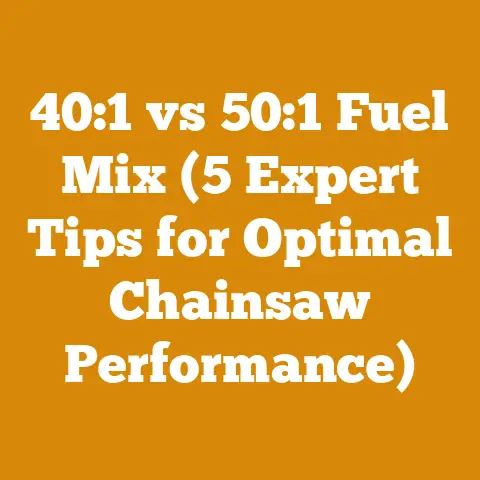Chainsaw Clutch Removal Tool (5 Pro Tips for Husqvarna 334xp)
Introduction: The Importance of Chainsaw Clutch Maintenance for Husqvarna 334xp Owners
Having spent countless hours felling trees, bucking logs, and milling lumber, I’ve learned firsthand the importance of a well-maintained chainsaw. I’ve seen clutches fail at the most inopportune times, leaving me stranded in the woods. It’s these experiences that have driven me to become meticulous about chainsaw maintenance, especially the clutch.
Why Remove the Clutch?
Before we dive into the how-to, let’s understand why you might need to remove the clutch in the first place. There are several reasons:
- Clutch Replacement: The most common reason is a worn-out or damaged clutch. Over time, the clutch shoes can wear down, the springs can weaken, or the clutch drum can become damaged.
- Clutch Cleaning: Sometimes, the clutch can become clogged with sawdust, oil, and debris. Removing the clutch allows for thorough cleaning.
- Crankshaft Seal Replacement: The crankshaft seal sits behind the clutch. If this seal is leaking, you’ll need to remove the clutch to access it.
- Engine Repair: In some engine repair scenarios, removing the clutch is necessary to access other components.
- Inspecting the Clutch Bearing: The clutch bearing is located inside the clutch drum and can fail over time, causing the clutch to not function properly.
Tools You’ll Need
Before you start, gather the necessary tools. Having the right tools makes the job much easier and safer:
- Clutch Removal Tool: This is the most crucial tool. It’s a specialized wrench designed to engage the clutch and allow you to loosen it. There are several types of clutch removal tools available, including those with a bar that fits into the piston stop hole or those that use a socket attachment. Make sure you get one specifically designed for Husqvarna chainsaws, or a universal one that fits.
- Piston Stop: A piston stop prevents the piston from moving when you’re loosening the clutch. This is essential to avoid damaging the engine.
- Socket Wrench: You’ll need a socket wrench to turn the clutch removal tool. The size of the socket will depend on the type of clutch removal tool you’re using.
- Screwdriver: A flathead screwdriver may be needed to remove the spark plug and any other components obstructing access to the clutch.
- Gloves: Protect your hands from grease, oil, and sharp edges.
- Safety Glasses: Protect your eyes from flying debris.
- Penetrating Oil: A good penetrating oil can help loosen a stubborn clutch.
- Shop Rags: Keep your work area clean and wipe up any spills.
- Torque Wrench: For re-installation, a torque wrench is essential to ensure the clutch is tightened to the correct specification.
- Needle Nose Pliers: To remove e-clips or retaining rings.
Key Concepts and Terminology
Before we proceed, let’s define some key terms:
- Clutch: The mechanism that connects the engine to the chain. It allows the engine to idle without the chain spinning and engages when the throttle is applied.
- Clutch Drum: The part of the clutch that the chain rides on. It’s connected to the chain sprocket.
- Clutch Shoes: The friction material that engages with the clutch drum.
- Clutch Springs: The springs that hold the clutch shoes in place.
- Crankshaft Seal: A seal that prevents oil from leaking out of the engine around the crankshaft.
- Piston Stop: A tool that prevents the piston from moving when you’re loosening the clutch.
- Green Wood: Freshly cut wood with high moisture content.
- Seasoned Wood: Wood that has been dried to a lower moisture content.
Step-by-Step Guide to Removing the Husqvarna 334xp Chainsaw Clutch
Here’s a detailed, step-by-step guide to removing the clutch on your Husqvarna 334xp:
Step 1: Preparation and Safety
- Disconnect the Spark Plug: Always disconnect the spark plug before working on your chainsaw. This prevents accidental starting and potential injury. Pull the spark plug boot off the spark plug.
- Secure the Chainsaw: Place the chainsaw on a stable surface. A workbench or sturdy table is ideal.
- Wear Safety Gear: Put on your safety glasses and gloves.
- Clean the Area: Clean the area around the clutch to remove any sawdust or debris.
Step 2: Remove the Chain and Bar
- Loosen the Bar Nuts: Use the bar wrench to loosen the bar nuts that hold the chain and bar in place.
- Remove the Chain: Carefully remove the chain from the bar.
- Remove the Bar: Slide the bar off the studs.
Step 3: Access the Clutch
- Remove the Clutch Cover: Remove the clutch cover, which is usually held in place by screws or nuts.
- Inspect the Area: Take a look at the clutch assembly. Note the orientation of the components. This will help you when you reassemble it.
Step 4: Install the Piston Stop
- Remove the Spark Plug: Use a spark plug wrench or socket to remove the spark plug.
- Insert the Piston Stop: Carefully insert the piston stop into the spark plug hole. Make sure it’s fully seated. The piston stop will prevent the piston from moving when you loosen the clutch.
Personal Experience: I once forgot to use a piston stop and ended up damaging the piston. It was a costly mistake that taught me the importance of using the right tools and following the proper procedures.
Step 5: Loosen the Clutch
- Engage the Clutch Removal Tool: Insert the clutch removal tool into the clutch. Make sure it’s securely engaged. The Husqvarna 334xp has a left-hand thread on the clutch, which means you’ll need to turn it clockwise to loosen it.
- Apply Penetrating Oil (If Needed): If the clutch is stuck, apply penetrating oil around the threads. Let it soak for a few minutes to help loosen the clutch.
- Use a Socket Wrench: Attach a socket wrench to the clutch removal tool.
- Loosen the Clutch: Using the socket wrench, turn the clutch clockwise to loosen it. You may need to apply some force. If it’s particularly stubborn, try tapping the clutch removal tool with a hammer.
Pro Tip: If you’re having trouble loosening the clutch, try heating it with a heat gun. The heat will help expand the metal and make it easier to loosen. Be careful not to overheat the clutch, as this can damage it.
Step 6: Remove the Clutch
- Unscrew the Clutch: Once the clutch is loosened, you should be able to unscrew it by hand. Turn it clockwise until it’s completely removed.
- Remove the Clutch Drum: After the clutch is removed, carefully slide the clutch drum off the crankshaft.
Step 7: Inspect the Components
- Inspect the Clutch: Examine the clutch shoes for wear and tear. Look for cracks, chips, or excessive wear. Check the clutch springs to make sure they’re not broken or weakened.
- Inspect the Clutch Drum: Check the clutch drum for damage. Look for grooves, cracks, or signs of overheating.
- Inspect the Crankshaft Seal: Inspect the crankshaft seal for leaks. If the seal is leaking, it will be wet with oil.
- Inspect the Clutch Bearing: Check the clutch bearing inside the clutch drum. It should spin freely and smoothly. If it’s rough or noisy, it needs to be replaced.
5 Pro Tips for Husqvarna 334xp Clutch Removal
Here are five pro tips that I’ve learned over the years:
- Use the Right Tool: Using the correct clutch removal tool is crucial. Don’t try to improvise with other tools, as this can damage the clutch or the engine. Invest in a quality clutch removal tool specifically designed for Husqvarna chainsaws.
- Apply Heat (Carefully): If the clutch is stuck, applying heat can help loosen it. Use a heat gun to gently heat the clutch. Be careful not to overheat it, as this can damage the clutch shoes or springs.
- Use Penetrating Oil: Penetrating oil is your friend. Apply it liberally to the threads and let it soak for a few minutes before attempting to loosen the clutch.
- Check the Crankshaft Seal: While you have the clutch removed, take the opportunity to inspect the crankshaft seal. If it’s leaking, replace it. It’s much easier to replace the seal with the clutch removed.
- Clean Everything: Before reassembling the clutch, clean all the components thoroughly. Use a parts cleaner or degreaser to remove any dirt, oil, or debris. A clean clutch will function more efficiently and last longer.
Reassembly
Reassembly is the reverse of disassembly. Here’s a step-by-step guide:
Step 1: Clean the Components
- Clean the Clutch Drum: Clean the inside of the clutch drum with a parts cleaner or degreaser.
- Clean the Clutch: Clean the clutch shoes and springs with a parts cleaner or degreaser.
- Clean the Crankshaft: Clean the crankshaft with a parts cleaner or degreaser.
Step 2: Install the Clutch Drum
- Slide the Clutch Drum onto the Crankshaft: Carefully slide the clutch drum onto the crankshaft.
Step 3: Install the Clutch
- Thread the Clutch onto the Crankshaft: Thread the clutch onto the crankshaft. Remember that the Husqvarna 334xp has a left-hand thread, so you’ll need to turn it counterclockwise to tighten it.
- Tighten the Clutch: Use the clutch removal tool and a socket wrench to tighten the clutch. Tighten it to the manufacturer’s specified torque. If you don’t have the torque specification, a good rule of thumb is to tighten it snugly, but not too tight.
Important Note: Over-tightening the clutch can damage the crankshaft or the clutch itself.
Step 4: Remove the Piston Stop
- Remove the Piston Stop: Remove the piston stop from the spark plug hole.
- Install the Spark Plug: Install the spark plug and tighten it to the manufacturer’s specified torque.
Step 5: Reinstall the Bar and Chain
- Install the Bar: Slide the bar onto the studs.
- Install the Chain: Install the chain onto the bar. Make sure the chain is facing the correct direction.
- Tighten the Bar Nuts: Tighten the bar nuts to the manufacturer’s specified torque.
Step 6: Reinstall the Clutch Cover
- Reinstall the Clutch Cover: Reinstall the clutch cover and tighten the screws or nuts.
Step 7: Test the Chainsaw
- Start the Chainsaw: Start the chainsaw and test the clutch. Make sure the chain spins freely when the throttle is applied and stops when the throttle is released.
Troubleshooting
Here are some common problems you might encounter:
- Clutch Slipping: If the clutch is slipping, the chain will spin slowly or not at all when the throttle is applied. This is usually caused by worn clutch shoes or weak clutch springs.
- Chain Spinning at Idle: If the chain is spinning at idle, the clutch is not disengaging properly. This is usually caused by a broken clutch spring or a worn clutch drum.
- Clutch Making Noise: If the clutch is making noise, it could be caused by a worn clutch bearing or a damaged clutch drum.
- Clutch Not Engaging: If the clutch is not engaging at all, it could be caused by a broken clutch spring or a damaged clutch drum.
Alternative Clutch Removal Methods
While the clutch removal tool is the recommended method, there are alternative methods you can use if you don’t have the tool. However, these methods are not recommended, as they can damage the clutch or the engine.
- Using a Screwdriver and Hammer: You can try using a screwdriver and hammer to loosen the clutch. Place the screwdriver on one of the clutch shoes and tap it with the hammer. Rotate the clutch and repeat the process until the clutch is loosened. This method is risky, as you can easily damage the clutch shoes or the clutch drum.
- Using a Strap Wrench: You can try using a strap wrench to loosen the clutch. Wrap the strap wrench around the clutch drum and tighten it. Then, use a socket wrench to turn the strap wrench. This method is less risky than using a screwdriver and hammer, but it can still damage the clutch drum.
Wood Processing and Firewood Preparation: The Role of a Well-Maintained Chainsaw
A well-maintained chainsaw is essential for efficient wood processing and firewood preparation. Whether you’re felling trees, bucking logs, or splitting firewood, a sharp, reliable chainsaw will make the job much easier and safer.
Felling Techniques
- The Importance of Proper Felling: Proper felling is crucial for safety and efficiency. It involves making a notch cut and a back cut to control the direction of the fall.
- Felling Wedges: Felling wedges are used to help direct the fall of the tree. They’re inserted into the back cut to prevent the tree from pinching the saw.
- Tree Size and Type: The felling technique will vary depending on the size and type of tree.
Bucking Logs
- Bucking for Firewood: Bucking logs into firewood involves cutting the logs into shorter lengths. The length of the firewood will depend on the size of your wood stove or fireplace.
- Bucking Techniques: There are several different bucking techniques you can use, depending on the size and type of log.
- Safety Considerations: Always wear safety glasses and gloves when bucking logs. Be aware of the potential for kickback.
Splitting Firewood
- Splitting by Hand: Splitting firewood by hand involves using an axe or maul to split the logs. This is a physically demanding task, but it’s a good way to get exercise.
- Hydraulic Log Splitters: Hydraulic log splitters make splitting firewood much easier. They use hydraulic pressure to split the logs.
- Wood Type and Splitting: The ease of splitting firewood will depend on the type of wood. Some woods, like oak and maple, are more difficult to split than others, like pine and fir.
Drying Firewood
- The Importance of Seasoning: Seasoning firewood is essential for efficient burning. Green wood has a high moisture content, which makes it difficult to burn and produces a lot of smoke.
- Drying Methods: The best way to season firewood is to stack it in a well-ventilated area for at least six months.
- Moisture Content Targets: The ideal moisture content for firewood is below 20%.
Case Study: I once worked on a project where we needed to fell a large number of oak trees. We used a combination of felling wedges and a hydraulic log splitter to efficiently process the wood. We stacked the firewood in a well-ventilated area and allowed it to season for a year before burning it. The result was a supply of high-quality firewood that burned cleanly and efficiently.
Safety Considerations
Safety is paramount when working with chainsaws and wood processing equipment. Here are some important safety considerations:
- Wear Appropriate Safety Gear: Always wear safety glasses, gloves, hearing protection, and chainsaw chaps.
- Inspect Your Equipment: Before using your chainsaw, inspect it for any damage or wear. Make sure the chain is sharp and properly tensioned.
- Use Proper Techniques: Use proper felling, bucking, and splitting techniques to avoid injury.
- Be Aware of Your Surroundings: Be aware of your surroundings and avoid working in hazardous conditions.
- Never Work Alone: Always work with a partner or let someone know where you’ll be working.
- Take Breaks: Take frequent breaks to avoid fatigue.
Conclusion
Removing the clutch on your Husqvarna 334xp chainsaw is a relatively straightforward process, but it’s important to follow the proper procedures and use the right tools. By following the steps outlined in this guide and incorporating the pro tips I’ve shared, you can safely and effectively remove your clutch for maintenance or replacement. Remember to always prioritize safety and take your time. A well-maintained chainsaw is a valuable tool for wood processing and firewood preparation, and proper clutch maintenance is essential for keeping your saw running smoothly.
Now that you understand the process of clutch removal, you can confidently tackle this task and ensure the longevity and performance of your Husqvarna 334xp chainsaw. Good luck, and happy wood processing!






